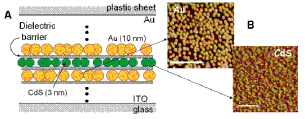Chemical and Biomolecular Research Papers -- Faculty Authors Series

Ravi Saraf Publications
Document Type
Article
Date of this Version
August 1995
Abstract
One of the possible uses for a conductive paste is as an adhesive in interconnect technology that could replace PbSn solder. The interconnections are expected to perform under a variety of environmental conditions, and with an applied voltage. Thus knowledge of their corrosion and dissolution resistance is of utmost importance. This is a study of the dissolution and protection of polymer/metal composite films, prepared with a high loading of silver or gold particles. Electrochemical tests were conducted in a droplet of triple-distilled water with or without benzotriazole (BTA) and BTA derivatives. Results indicate that, in spite of some protection obtained by the polymer, silver paste dissolution at high anedic potentials is rapid, reaching values of 10-1 A/cm2, which corresponds to a catastrophic silver removal rate of at least 35.6 nm/s. With a reservoir of azole in the corrosive environment, this rate can be reduced by up to five orders of magnitude. This azole effect greatly reduces the probability of electrolytic silver migration, but the Ag dissolution rate is still higher than the anodic activity shown by Au paste under the same conditions.


Comments
Published in J. Electrochem. Soc., Vol. 142, No. 8, August 1995. Copyright The Electrochemical Society, Inc. Used by permission.